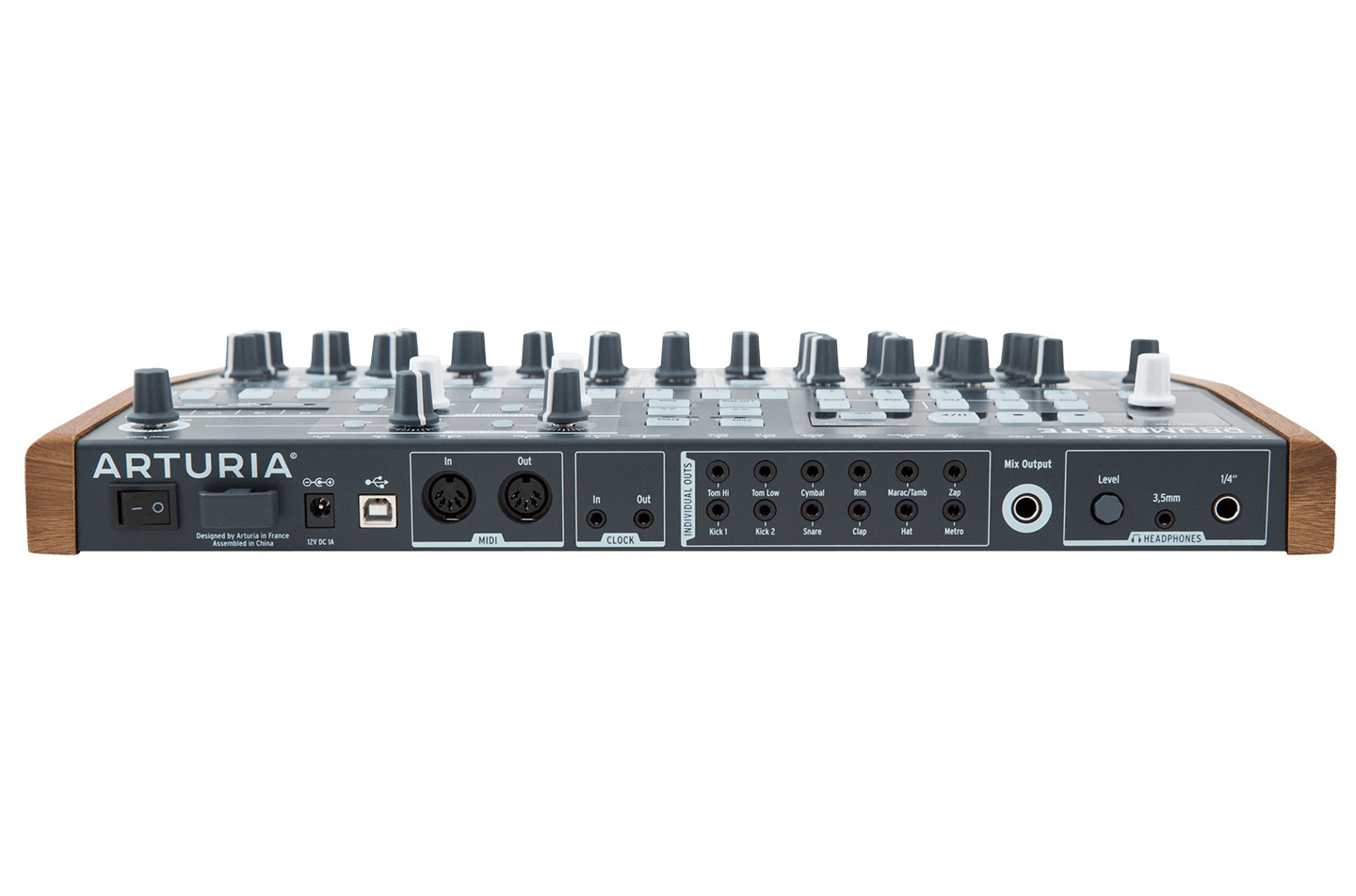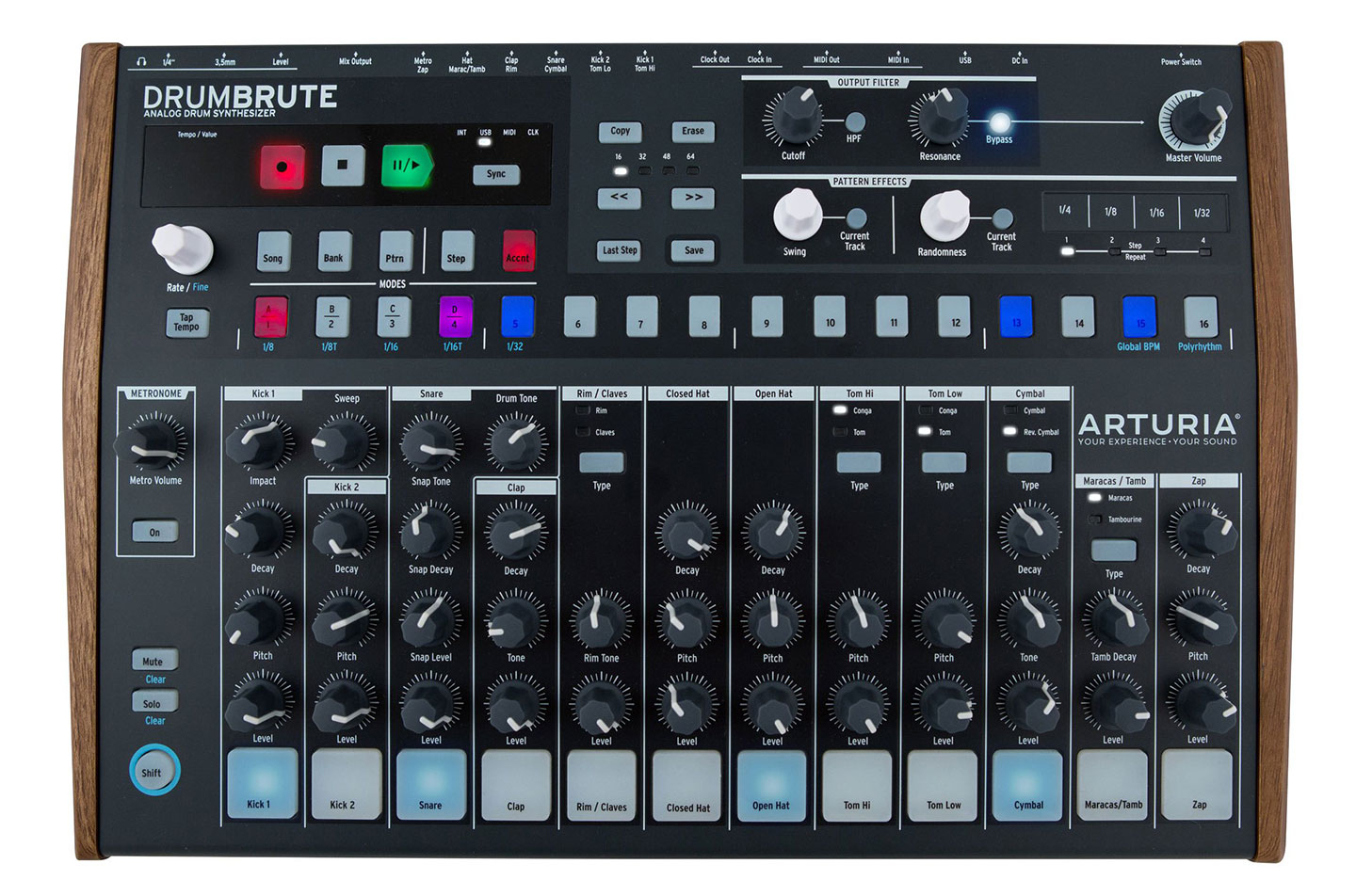- Arturia's Minibrute and Microbrute were very successful products. They simply delivered what the market wanted: a fully analogue keyboard synth for as low a cost as possible. They were functionally straightforward and delivered sonically, and subsequently appealed both to beginners and experienced musicians on a budget. It will come as little surprise that the Drumbrute is a successor to those synths. It's based on the same design philosophies but comes with appropriately robust sequencing capabilities.
All of the Drumbrute's sounds are divined from analogue circuitry, and they're generally solid and tough. However, the Brute Factor feature—a feedback loop for creating overdrive—from the previous two synths has been dropped, so some users might need to treat sounds with distortion to get the sizzle and crunch they're looking for. There are two weighty kicks, the first being aggressive and hardcore while the second is more subby. The mid-range sounds, such as the toms and rim, are bouncy and upfront. On the other hand, the hats and cymbal didn't sizzle as much as I'd have liked. However, there are 11 separate outs on the back panel. This feature is vital in making the Drumbrute useful for more involved production and performance situations. The ability to treat individual sounds with distortion and compression makes up for any perceived lack of oomph, sidechain compression can introduce a subtle sense of groove while reverb and pan can help you expand a two-dimensional soundstage.
There are seventeen sounds in total, which is plenty to work with. They include things like Reverse Cymbal and Zap, which is a sine wave with decaying pitch that can be rhythmically useful with a short decay setting. The controls on these sounds are simple. The Kick 1 and Snare instruments feature extra controls such as Sweep and Impact on the former and Snap Tone and Drum Tone on the latter but most other voices are served by a either a Tone or Pitch knob and a Decay parameter. The Open and Closed Hats, Cymbal and Zap have all three of these controls while every instrument has a knob for setting the level. You can't record parameter changes into your loops—presumably the decision was made to keep the price low rather than implement the required digital control. This kind of simplicity is what you get if you want analogue circuitry at as low a price as possible. But you can make up for this by introducing variation with sonic treatment on the multiple outs.
The step sequencer is straightforward to use but includes more involved features if you dig a bit deeper. It extends up to 64 steps, and you don't have to stick to divisions of sixteen, which allows for non-standard time signatures. 64 pattern slots are organised into four banks that can be chained together into songs. The individual patterns can also have their own tempos, independent from the rest of the track. You can input steps and accents using the step buttons or play in patterns using the pads along the bottom. The sequencer steps can be set to eighth, 16th or 32nd notes, with the eighth and 16th varieties available in triplets. Each step can be set to trigger a sound one, two, three or four times, which allows you to create rolls.
Recording can be quantised or unquantised. The latter setting only records one hit per step but it can land anywhere between plus or minus fifty percent of the central time. You can also shift individual hits manually: if you're inputting patterns with the step buttons, holding down the appropriate step and using the Swing knob enables the building of unique and tailored grooves.
Swing can also be applied to the entire pattern or set to different amounts on individual drum tracks. Here it is applied only to the hi-hats.
One particularly nice feature is the ability to set each drum part's loop length separately down to the level of a single step. Using this Polyrhythm setting lets you build beats that shift against each other in alignment. All of this enables a great deal of flexibility with your patterns.
There are also a few more performance-oriented features. The Randomness knob applies a controllable amount of random variation to the rhythms and accents of either the whole pattern or an individual part. There are also mute and solo buttons that can be applied instantly to groups of instruments, while the Step Repeat ribbon lets you loop beats down to 32nd note rolls.
Like the other members of the Brute family, there's a Steiner-Parker filter on the output that can be set to high- or low-pass with adjustable resonance. You can also use the MIDI Control Centre software to save and manage settings, patterns and songs for use in sets. In terms of integration into a wider setup, there are four different sync sources, and the Drumbrute can act as a source for other devices; there's MIDI in and out, where it can be triggered by external MIDI, deliver MIDI messages from its pads or the transport section and sync with external devices; and there's a USB port that sends the same information to and from your DAW.
The Drumbrute deserves to be as successful as its predecessors. It's a very neatly designed product that's easy to use on the surface and full of useful features once you get deeper. Some people saw the Mini and Microbrutes as toys rather than serious pieces of kit, and there will likely be those who feel similarly about the Drumbrute. But as part of a more extensive setup, it becomes a serious tool whose simplicity lends itself to an upfront and spontaneous approach to music making. It may not be the most groundbreaking product around but it's a very solid one that's likely to become yet another consumer favourite.
Ratings:
Cost: 4.5
Versatility: 3.4
Ease of use: 4.6
Sound: 3.7
 There are also a few more performance-oriented features. The Randomness knob applies a controllable amount of random variation to the rhythms and accents of either the whole pattern or an individual part. There are also mute and solo buttons that can be applied instantly to groups of instruments, while the Step Repeat ribbon lets you loop beats down to 32nd note rolls. Like the other members of the Brute family, there's a Steiner-Parker filter on the output that can be set to high- or low-pass with adjustable resonance. You can also use the MIDI Control Centre software to save and manage settings, patterns and songs for use in sets. In terms of integration into a wider setup, there are four different sync sources, and the Drumbrute can act as a source for other devices; there's MIDI in and out, where it can be triggered by external MIDI, deliver MIDI messages from its pads or the transport section and sync with external devices; and there's a USB port that sends the same information to and from your DAW. The Drumbrute deserves to be as successful as its predecessors. It's a very neatly designed product that's easy to use on the surface and full of useful features once you get deeper. Some people saw the Mini and Microbrutes as toys rather than serious pieces of kit, and there will likely be those who feel similarly about the Drumbrute. But as part of a more extensive setup, it becomes a serious tool whose simplicity lends itself to an upfront and spontaneous approach to music making. It may not be the most groundbreaking product around but it's a very solid one that's likely to become yet another consumer favourite. Ratings: Cost: 4.5 Versatility: 3.4 Ease of use: 4.6 Sound: 3.7
There are also a few more performance-oriented features. The Randomness knob applies a controllable amount of random variation to the rhythms and accents of either the whole pattern or an individual part. There are also mute and solo buttons that can be applied instantly to groups of instruments, while the Step Repeat ribbon lets you loop beats down to 32nd note rolls. Like the other members of the Brute family, there's a Steiner-Parker filter on the output that can be set to high- or low-pass with adjustable resonance. You can also use the MIDI Control Centre software to save and manage settings, patterns and songs for use in sets. In terms of integration into a wider setup, there are four different sync sources, and the Drumbrute can act as a source for other devices; there's MIDI in and out, where it can be triggered by external MIDI, deliver MIDI messages from its pads or the transport section and sync with external devices; and there's a USB port that sends the same information to and from your DAW. The Drumbrute deserves to be as successful as its predecessors. It's a very neatly designed product that's easy to use on the surface and full of useful features once you get deeper. Some people saw the Mini and Microbrutes as toys rather than serious pieces of kit, and there will likely be those who feel similarly about the Drumbrute. But as part of a more extensive setup, it becomes a serious tool whose simplicity lends itself to an upfront and spontaneous approach to music making. It may not be the most groundbreaking product around but it's a very solid one that's likely to become yet another consumer favourite. Ratings: Cost: 4.5 Versatility: 3.4 Ease of use: 4.6 Sound: 3.7